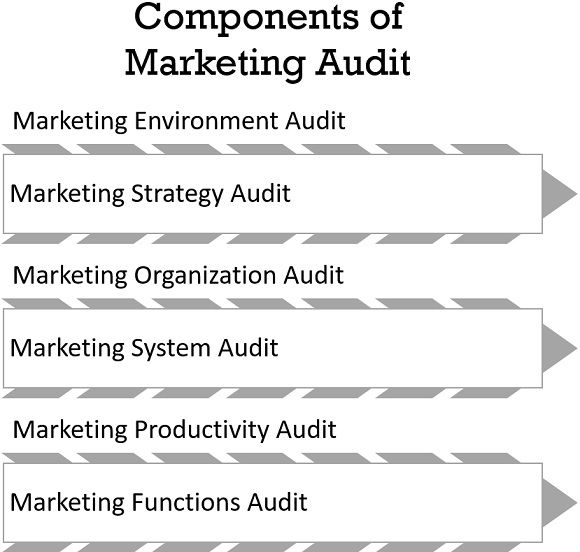Definition: Marketing Audit is an overall analysis of a company’s marketing strategies and objectives in a systematic manner so as to find out the problematic areas and opportunities and urging a plan to improvise the company’s marketing performance. It is essential as it analyzes the external and internal situations.
It is also going to analyze the past performance and the present marketing activities and also identifies the functions which require more attention for future activities.
Content: Marketing Audit
- Reasons for Conducting a Marketing Audit
- How Marketing Audit should be?
- Components of Marketing Audit
- Conclusion
Reasons for Conducting a Marketing Audit
As it’s human nature if we don’t learn from our mistakes done in the past, we continue to make similar mistakes in future also, and to understand such marketing audit is performed which helps us in
- Recognizing the reason for success or failure in the market.
- It teaches us about the future course of actions.
How Marketing Audit should be?
Marketing Audit should be:

- Comprehensive
It should be comprehensive, which covers all the areas of marketing from the identification of the need of the customers to the satisfaction of the need of the customers which includes starting from a new product development process. Then product strategies, pricing strategies, so it should convert entire from a vision mission of the company to salesforce analysis or customer’s satisfaction.
- Systematic
It should have a well-defined systematic step to follow to teach the desired goals.
- Independent
It must be independent and not influenced by the auditor or the people who are in the organization that’s why it is recommended that audit should be done by a third party and not from an internal people.
- Periodical
It should have some regular periodical frequency like quarter, half-yearly or yearly audit should be done.
Components of Marketing Audit
These are some of the major components:

Marketing Environment Audit
Marketing Environment Audit is classified into two categories, i.e., Micro Environment and Macro Environment in which Macro Environment consists of Economic, Social, Technological, Cultural, Demographic, Political and Environmental Audit. The auditor should look at these parameters to whom these products have been made, i.e., demographic, age, gender, etc.; thus, what exactly the political environment affects on the business is:
- Economic Factor: What is the Gross Domestic Product (GDP) and what exactly is the economic situation of the organization, i.e., the external environment.
- Social Factor: The auditor should also check Social Environment.
- Technology Factor: Whether there is an impact of technology on marketing or not.
- Cultural Factor: Where the cultural activity is going to shift, if it is an agricultural product, the environment impacts a lot on the marketing strategies of the company.
So, the auditor has to identify these major areas under Macro Environment that should be audited as well as the customer’s profile, competitors should also be taken into consideration in this audit. Then, the distribution, i.e., distribution general, vendors, suppliers, promoter and even public that directly and indirectly associated with the organization.
Marketing Strategy Audit
It comprises of the business mission, vision, objectives, goals of the firm which is also needed to be assessed by the auditor, so whether the activities matched with the mission and objectives of the firm.
Marketing Organization Audit
As we all know, the hierarchy plays an important role in the reporting system so whether there is some impact on the structure of an organization. Thus, the reporting parameters should be checked, i.e., with a formal structure, functional structure, etc. which the firm follows exactly organization and whether it is efficient or not.
Marketing System Audit
Marketing System Audit is what exactly the information systems that have been defined as getting information from the retailers, consumers and there are so many information system parameters or reporting system rather than. So, whether that reporting system is properly defined or not that should also be checked properly. The planning system in Marketing System Audit is how exactly the marketing planning has been done and what are the points that should be considered that should also be checked. The auditor should also check the New Product Development (NPD) System under the Marketing Audit.
Marketing Productivity Audit
It is a profitability analysis, cost-effective analysis. In which Profitability analysis defines how much expenditure has been done on marketing and how much profits have been earned through that activity. Cost-effective analysis has been done or not while doing a marketing operation should also be checked.
Marketing Functions Audit
Marketing Functions Audit consist of 4 p’s, i.e., product, price, place and promotion; thus, strategies audit such as product strategies, pricing strategies, distributional strategies and promotional strategies audit should also be done. Salesforce is one of the major areas; by the way, an individual’s capability should be checked with the help of Marketing Audit. So, these are some of the broad perspective or components of the Marketing Audit; a firm can decide some of the components that should be excluded according to the type of firm or some of the parameters that should be added under a marketing audit as per the firm’s requirement.
Conclusion
Marketing Audit is an organization’s performance in the market that depends on three factors, i.e., market position, the organization’s outside opportunities and threats related to its business environment and the way the organization is coping with its internal strengths and weaknesses.
Anne says
Good